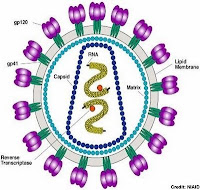In AIDS the number of CD4+ T cells, a subpopulation of T lymphocytes, diminishes drastically. Since these cells are concerned with fighting microorganisms, the immunity takes a severe beating, making the body vulnerable to foreign invaders. Clinically the 4H mnemonic was coined: Homosexuals (and heterosexuals), Heroin addicts (and other intravenous drug users), Hemophiliacs (and those requiring blood transfusions) and Haitians.
The pattern of spread pointed it clearly to the scientists that it had something to do with blood and body fluids. But the etiologic agent foxed the researchers. In the early 1982 Robert C Gallo with Max Essex proposed that it could be the handiwork of a virus, a retrovirus. Their assumption was based on another virus, feline leukemia virus, which caused T cell depletion in addition to leukemia.
They searched for similarities between DNA and RNA of some tissues of AIDS patients, and HTLV-1 and 2 (Human T cell Lymphotropic Virus; related to HIV). Away in France, Luc Montagnier was stimulated in part by their ideas. In early 1983, Dr Gallo sent Montagnier IL-2 and antibodies against the HTLV's. Montagnier and his co-workers had found a new retrovirus in a patient with lymphadenopathy, and they could distinguish it from the HTLV-1 and with the antibodies Gallo provided. While the French called it the LAV (Lymphadenopathy Associated Virus), the Americans called it HTLV3. It is now called Human Immunodeficiency Virus (HIV).
The virus has two important glycoproteins, GP120 and GP41. GP120 binds with CD4 molecules present in the host CD4+ T lymphocytes and some other cells.
 This causes a conformational change in the GP120 molecule, allowing it to draw the virus near the host cell. The membranes fuse and the viral core material gains entry. The materials comprise of 2 identical RNAs, an enzyme called reverse transcriptase, and another key enzyme called integrase. Normally, DNA is transcribed to form RNA, a process called transcription. Reverse transcriptase does just the opposite. It makes DNA out of RNA (reverse transcription). Integrase then integrates this viral DNA with the host DNA. The virus thus, not only reproduces with each division, it usurps all control from the host cells. The cells now do what they are told to do. The virus remains for the lifetime of the cell, making AIDS an incurable disease.
This causes a conformational change in the GP120 molecule, allowing it to draw the virus near the host cell. The membranes fuse and the viral core material gains entry. The materials comprise of 2 identical RNAs, an enzyme called reverse transcriptase, and another key enzyme called integrase. Normally, DNA is transcribed to form RNA, a process called transcription. Reverse transcriptase does just the opposite. It makes DNA out of RNA (reverse transcription). Integrase then integrates this viral DNA with the host DNA. The virus thus, not only reproduces with each division, it usurps all control from the host cells. The cells now do what they are told to do. The virus remains for the lifetime of the cell, making AIDS an incurable disease.Professors Luc Montagnier and Françoise Barré-Sinoussi were awarded the Nobel Prize in Physiology or Medicine for their 1983 identification of what was later named the human immunodeficiency virus1 (HIV1). They shared the prize with Harald zur Hausen of Germany, who discovered that human papillomavirus (HPV) caused cervical cancer, the second most common cancer in women.
Robert Gallo wasn’t among them. Like the Nobel Prize in Chemistry this too is disheartening. Anthony S. Fauci, director of the National Institute of Allergy and Infectious Diseases said "Gallo deserves enormous credit…It's a shame you can't give it to four people, because Gallo's contributions were enormous". It really is and this leaves us in a sad note.
A splendid Youtube video depicts how the virus gains entry, replicates, the areas where pharmacological intervention is carried out and many more. Watch this.
References:The discoveries of human papilloma viruses that cause cervical cancer and
of human immunodeficiency virus
Robert C Gallo (2006). A reflection on HIV/AIDS research after 25 years Retrovirology, 3 (1) DOI: 10.1186/1742-4690-3-72
1 comment:
Hi Amiya!
Happy New Year to you, my friend. I've expressed my gratitude for your assistance in a post and I'm hoping you can find time to view it.
Please click on my name to view.
Post a Comment